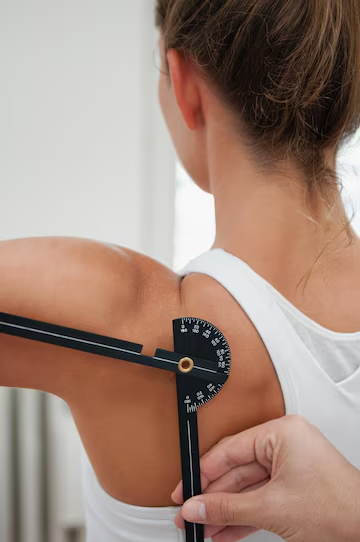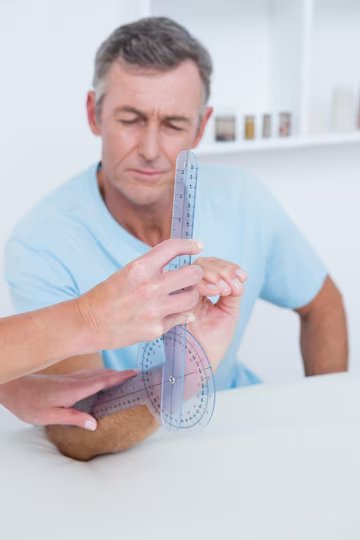Range of motion (ROM) refers to the extent and direction a joint can move in the body. Proper assessment of ROM is crucial for evaluating functional limitations and determining the effectiveness of therapeutic interventions in occupational therapy (OT).


Terminology
- Passive Range of Motion (PROM):
The therapist moves the joint without any assistance from the patient. - Active Range of Motion (AROM):
The patient actively moves the joint independently. - Active Assistive Range of Motion (AAROM):
The patient moves the joint with some assistance from the therapist or external support to eliminate gravity. - Within Normal Limits (WNL):
The range of motion is within the normal expected range for a specific joint, compared to standardized norms. - Within Functional Limits (WFL):
The range of motion is sufficient for the patient to perform daily functional tasks.
Importance of Range of Motion
- Functional Independence: Adequate ROM enables individuals to perform activities such as dressing, eating, or reaching objects.
- Identifying Deficits: OT practitioners (OTPs) use goniometers to measure ROM in degrees, which helps identify limitations in function.
- Guiding Treatment Plans: Based on the ROM findings, OTPs design interventions to maintain, restore or improve motion.
Common Movements of the Upper Extremities
Shoulder Movements:
- Flexion: Moving the arm forward and upward.
- Extension: Moving the arm backward.
- Abduction: Lifting the arm away from the body.
- Adduction: Moving the arm back towards the body.
- Internal and External Rotation: Rotating the arm inwards or outwards at the shoulder joint.
Elbow and Wrist Movements:
- Flexion/Extension: Bending and straightening the elbow or wrist.
- Supination/Pronation: Rotating the forearm so the palm faces upward (supination) or downward (pronation).
How ROM Is Measured
- Screening for Limitations: By observing functional movements.
E.g.: Tasks like dressing, reaching, or writing reveal functional ROM deficits. - Using a Goniometer:
- A goniometer is aligned with the joint’s axis.
- The stationary arm is placed proximal to the joint.
- The movable arm follows the movement of the joint.
Total Active Motion (TAM)
Total active motion (TAM) is described by the American Society for Surgery of the Hand as the sum of active MCP, PIP and DIP arcs of motion in degrees of an individual digit. This calculation can then be compared to the TAM of the contralateral hand.
Treatment Techniques to Improve Range of Motion
- Passive Stretching:
The therapist gently moves the joint through its full range to maintain or increase ROM. - Active Range of Motion Exercises:
Functional tasks are used such as reaching or lifting objects. - Active Assistive Exercises:
Assisted exercises for weak muscles. - Joint Mobilization:
Gentle manipulation of joints to improve mobility.
Common Conditions Leading to ROM Deficits
- Contractures: Tightening of muscles, ligaments, or tendons that restrict movement.
- Neurological Conditions: Stroke, cerebral palsy, or nerve injuries.
- Musculoskeletal Injuries: Fractures, arthritis, or tendon damage.
Conclusion
Assessing and improving range of motion is necessary in the field of occupational therapy. With accurate measurement tools like goniometers and targeted interventions,OTPs help individuals regain mobility, independence, and improve their quality of life.
For detailed guides, expert tips, and video tutorials on ROM measurements, explore our comprehensive member resources today!
Ready to elevate your OT practice? Sign up for a free trial and access expert-level resources to improve your clinical skills and patient outcomes.
What is Range of Motion (ROM) in occupational therapy?
Range of Motion (ROM) is a critical aspect of occupational therapy that helps assess functional limitations and the success of therapeutic interventions. It plays a significant role in aiding patients to regain independence.
How is the Range of Motion measured in occupational therapy?
ROM is measured using a goniometer, which is aligned with joint axes using stationary and movable arms. The process may include screening for limitations through observed tasks like dressing, to detect any functional deficits.
What are common examples of upper extremity movements in ROM testing?
Common upper extremity movements in ROM testing include shoulder flexion, extension, abduction, adduction, and rotations, as well as elbow and wrist flexion/extension and supination/pronation.
Why is understanding ROM important for passing the NBCOT® exam?
Understanding ROM is crucial for the NBCOT® exam because it is vital for assessing functional independence, identifying limitations using tools like goniometers, and guiding therapeutic interventions to improve patient outcomes.
What treatment techniques are used to improve ROM in patients?
Techniques to enhance ROM include passive stretching, active exercises, active assistive exercises for weaker muscles, and joint mobilization to improve joint freedom.


